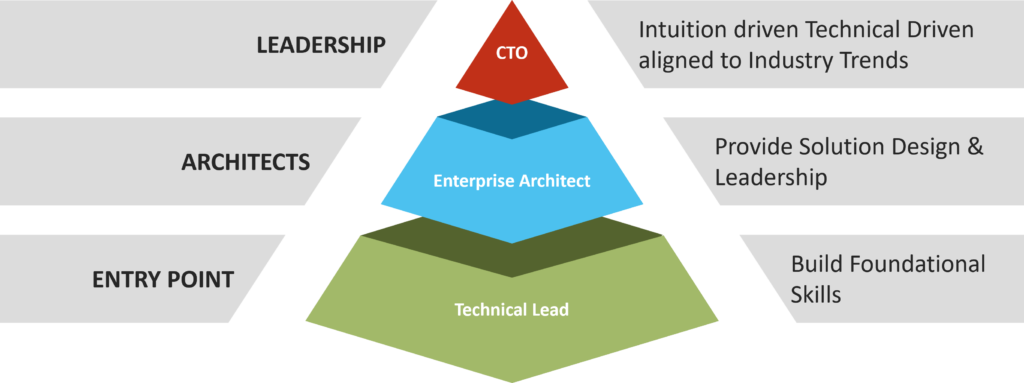So, you want to become an architect in IT landscape, and looking for a plan or details on skills to pick up? You are at the right place to understand how to become an architect and get a roadmap.
Becoming an architect is a journey, not a destination. It requires a combination of technical expertise, strategic thinking, and business acumen. With dedication and continuous learning, you can build a successful career in this exciting and challenging field.
The role of an architect in today’s digital landscape is akin to a master builder, crafting intricate and scalable solutions from the ground up. But what does it take to become one? Let’s explore the path.

Understanding the Role
An architect is a strategic thinker, a technical expert, and a business-savvy individual who designs, builds, and manages complex technology infrastructures. They are the visionaries who translate business requirements into robust, secure, and efficient cloud solutions.
Technology is constantly evolving. Successful architects are lifelong learners. Stay updated on industry trends, new technologies, and best practices.
Beyond technical expertise, an architect must possess a deep understanding of the business landscape. This involves aligning technology solutions with the organization’s goals, ensuring that every architectural decision contributes to the broader strategic vision. An architect’s role is not just about creating efficient systems but also about driving innovation, optimizing resources, and enabling the business to adapt quickly to market changes.

Collaboration is another critical aspect of the role. Architects must work closely with various stakeholders, including developers, project managers, and executives, to ensure that the solutions they design are not only technically sound but also meet the needs of the business. This requires strong communication skills and the ability to bridge the gap between technical and non-technical teams.
In essence, an architect is a leader who shapes the technological direction of the organization, ensuring that it is well-positioned to meet current challenges and future opportunities.
The Foundation: Technical Proficiency
To elevate your career and become a key player in the tech industry, join Lead With Tech’s Aspiring Architect Program! Gain hands-on experience, learn from industry experts, and master the skills needed to design innovative solutions that drive business success. Don’t miss this opportunity to shape your future as a leading architect
To lay a solid foundation for a career as an architect in the IT landscape, technical proficiency is paramount. This includes:
Understanding of Core Technologies: Proficiency in programming languages/ understanding of databases, networking, and operating systems.
System Design and Architecture: Ability to design scalable, efficient, and secure systems. This involves the ability to translate complex requirements into technical solutions.

Cloud Computing: Knowledge of cloud platforms/ Architects need to design solutions that leverage the benefits of the cloud.
- DevOps and Automation: Familiarity with DevOps practices (Docker, Kubernets?) is crucial for modern architecture.
- Security Best Practices: Implementing robust security measures at every layer of the architecture to protect data and systems from vulnerabilities and threats.
Design and Architecture Skills
Design and architecture skills are essential for an architect, requiring a blend of holistic vision, creative problem-solving, detailed design, user-centric focus, and adaptability to changing requirements.
Holistic View: Developing the ability to see the big picture and how different components of a system interact with each other. This includes both the technical and business aspects.
Creative Problem-Solving: Innovating and coming up with creative solutions to complex problems. This requires a blend of logical thinking and creative insight.

Detailed Design: While maintaining a high-level view, being able to drill down into the details to ensure that designs are practical and implementable.
User-Centric Design: Keeping the end-user in mind and ensuring that the solutions are user-friendly and meet the needs of the business.
- Agility and Flexibility: Being able to adapt designs and architectures in response to changing requirements or new information.
The Career Path
Becoming an architect requires a good foundational skills and ability to be logical and creative at the same time. You will need to come up innovative and creative solution while show the ability to implement in a detailed and seamless methodology.
There are 4 levels of architect that you can aspire depending on your current experience level and knowledge.
Technical Lead – Foundational Roles
Acquire expertise in crafting module designs derived from high-level architectural plans. This skill ensures that the foundational blueprints are robust and clear, enabling developers to implement the code efficiently. Effective module design minimizes errors and streamlines the development process.
Dreaming of a career where you can design the future of technology? Lead With Tech’s Aspiring Architect Program is your gateway! Our program equips you with the knowledge, skills, and mentorship to excel as a tech architect. Start your journey today and unlock your potential in a rapidly evolving industry!
Technical Architect
Build proficiency in creating technology-specific architectures by leveraging specialized knowledge. This involves understanding the unique requirements and capabilities of various technologies to develop tailored solutions. Such expertise allows for optimized performance and integration of technology components.
Solution Architect
Focus on formulating technology-neutral solutions, which requires the ability to abstract and generalize across different tech stacks. This includes defining delivery methods and timelines, ensuring that projects remain on track and within scope. Establishing governance frameworks is crucial for maintaining consistency and quality throughout the development lifecycle.
Enterprise Architect
Design enterprise-wide initiatives that aim to develop solutions maximizing value realization and reusability. This entails a comprehensive understanding of the business objectives and aligning architectural strategies accordingly. Implementing strong governance frameworks ensures that solutions are scalable, sustainable, and adhere to organizational standards.

Beyond Architect
Once you’ve reached the pinnacle of architectural roles, there’s still room for growth. Moving beyond the role of an architect often means transitioning into broader leadership roles where you’re not just influencing technology but also shaping the strategic direction of the entire organization.
As a Director of Technology or Chief Technology Officer (CTO), your focus shifts to aligning technology strategy with business objectives, driving innovation, and ensuring that the organization remains competitive in a rapidly evolving market. You’ll need to have a strong grasp of business acumen, as decisions at this level can have significant financial implications. Moreover, leadership becomes even more critical, as you’ll be guiding large teams, mentoring future leaders, and championing a culture of continuous improvement.
In these roles, you’re not just building systems—you’re building the future of the company.
Also, Business Acumen
An architect must excel not only in technical skills but also in understanding the broader business context. Strategic thinking is essential, as it involves aligning architectural solutions with the company’s vision and goals, ensuring that technology supports and drives business objectives. Along with this, cost management also plays a crucial role, requiring an understanding of budgeting and financial planning to design solutions that are both effective and cost-efficient.

Effective communication is vital for translating complex technical concepts to non-technical stakeholders, helping to gain their support and buy-in. Additionally, leadership and team collaboration are key, as architects need to guide teams and coordinate with various departments to ensure cohesive and integrated solutions.
Staying informed about industry trends, competitive landscapes, and emerging technologies is also important to maintain a competitive edge and drive innovation within the company.
Conclusion
By developing these skills and following this career path, you can build a successful and rewarding career as an architect in the IT landscape. Continuous learning and adaptation are key, as the technology field is ever-evolving.
Would you like to focus on a specific aspect of becoming an architect, such as the importance of certifications or the soft skills required? Contact Lead With Tech.
